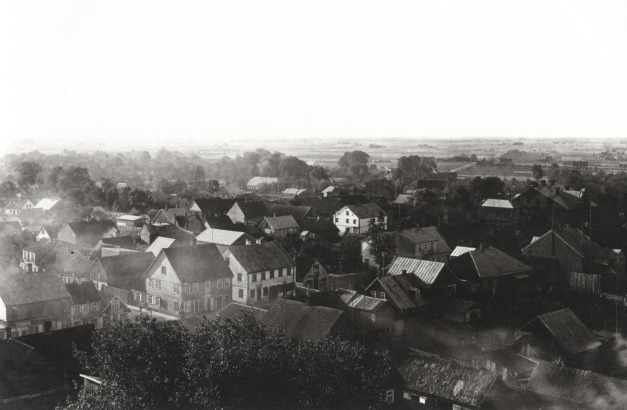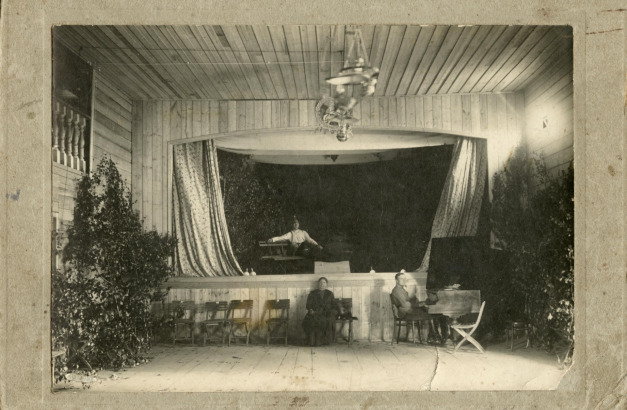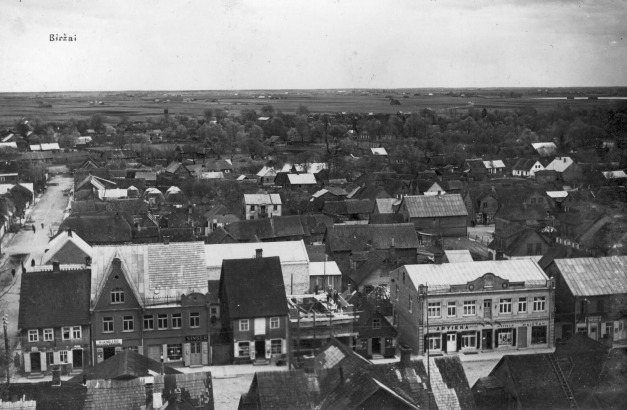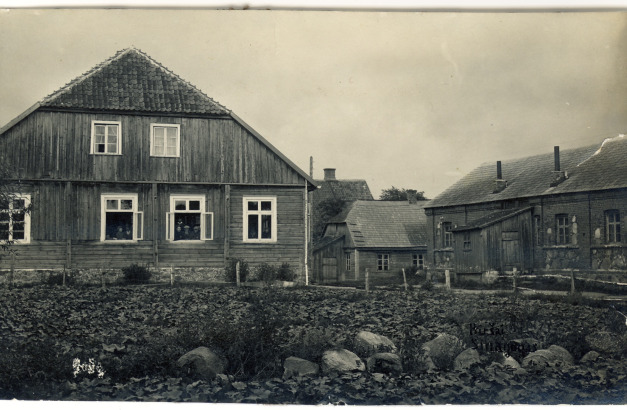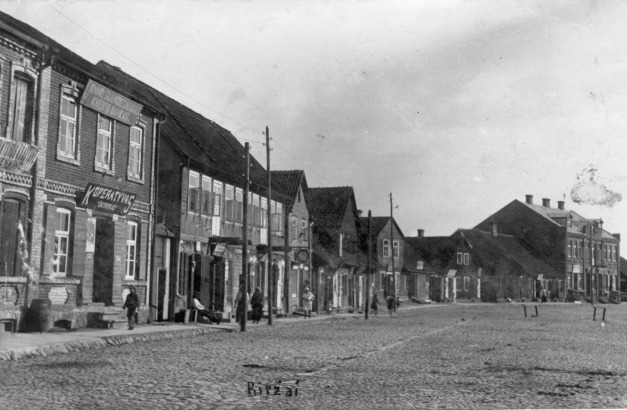Šiaurės Lietuvoje strategiškai svarbioje vietoje esantis Biržų miestas per savo kiek ilgesnę nei 500 metų istoriją atliko itin svarbų vaidmenį saugant Lietuvos žemes nuo į jas besiveržiančių priešų kariuomenių. Biržai nuo XV a. vidurio buvo Radvilų giminės rankose. Biržų-Dubingių Radvilų giminės šakos atstovų globojama gyvenvietė netruko išaugti į miestą, tapusiu Biržų kunigaikštystės centru. Miesto didybę XVI a. įtvirtino viena iš pažangiausių visoje LDK bastioninių pilių, kurią juosė seniausias dirbtinis vandens telkinys Lietuvoje – Širvėnos ežeras.
Oficialia žydų įsikūrimo Biržuose data laikomi 1594 m., kuomet vietos žydams buvo suteikta privilegija atvėrusi jiems galimybes teisėtai gyventi mieste. Žinoma, kad XVII a. Biržuose gyveno karaimų ir žydų rabinistų bendruomenės. To paties amžiaus viduryje priešų kariuomenės nusiaubė LDK. Biržų tvirtovė, būdama viena iš svarbiausių visoje kunigaikštystėje, neabejotinai patraukė priešiškai nusiteikusių valstybių žvilgsnį: XVII a. viduryje ir XVIII a. vykusių karų metu Biržai itin nukentėjo. Pasibaigus karams vietos žydai atliko itin svarbų vaidmenį atstatant miestą. XVIII a. vidurio miesto inventoriuose nurodoma, kad Biržuose žydai gyveno 65 namuose. Iki amžiaus pabaigos žydų bendruomenė pastebimai išaugo – ją sudarė 1283 žmonės, įskaitant aplinkiniuose kaimuose gyvenančius žydus. Biržų žydų bendruomenė išliko viena skaitlingiausių visoje Lietuvoje ir XX amžiuje. Remiantis 1925 m. duomenimis, Biržus savo namais laikė apie 3000 žydų.
Biržuose žydų gyvenamoji erdvė pradėjo formuotis XVII a. antrojoje pusėje. Tuo metu žydai gyveno 3 gatvėse, esančiose šalia tvirtovės bei vedančiose į pagrindinę turgaus aikštę. XX a. pradžioje žydai koncentruočiau gyveno dabartinėse Rinkos, Dagilio, Tilto, Kęstučio, Kreivojoje, Apaščios, Radvilos, Žemaitės bei Karaimų gatvėse. Pastarosios gatvės pavadinimas bei išlikusios bendros senosios žydų ir karaimų kapinės primena apie iki XVIII a. pirmosios pusės čia gyvenusius karaimus. Biržų miestą siaubė ne tik karai, tačiau ir taikos metu kildavę gaisrai, kurie ne kartą nuniokojo miestą. Pirmoji sinagoga buvo pastatyta dar XVII a. pabaigoje. XIX a. antrojoje pusėje Biržų žydai buvo pasidalinę į dvi bendruomenes: chasidų ir mitnagedų, atstovavusias skirtingas judaizmo tikėjimo judėjimus. Abi šios bendruomenės turėjo atskirus maldos namus. Tarpukariu mitnagedai jų turėjo 5, tuo tarpu chasidai – vienerius. Dalis žydų maldos namų, nors ir smarkiai pakeitę savo išvaizdą, išliko iki šių dienų.
Kaip ir daugumoje Lietuvos miestų, Biržuose žydai nuo pat įsikūrimo vertėsi tradiciniais verslais: prekyba, amatininkyste ir smuklių laikymu. XIX a. vietos žydai įsitraukė į linų bei medienos prekybą. Miesto ekonominį potencialą padidino 1922 m. nutiestas siaurasis geležinkelis, sujungęs Biržus su Panevėžiu. XX a. vietos žydų tarpe buvo krašte pagarsėjusių gydytojų, ir teisininkų, teikusių paslaugas visiems miesto gyventojams. Daktaras Abraomas Zalmanas Levinas turėjo tuo metu itin retą rentgeno kabinetą. Biržų žydai vietos gyventojus supažindino su XIX ir XX a. pradžios technologiniais stebuklais - fotografija ir kinu. Boruchas Michelsonas savo foto ateljė įamžino nemažą dalį tarpukario gyventojų, o antai dabartinėje J. Basanavičiaus gatvėje ugniagesių draugijos pastate buvo įsikūręs Chackeliui Gendreliui priklausęs kino teatras ,,Odeon”. Lietuvos nepriklausomybės metais Biržų žydų bendruomenė buvo guvi ir energinga. Mieste veikė Tarbut ir Javne tinklo žydų mokyklos, o 1930 m. Biržuose duris pravėrė maža ješiva – judaizmo dvasinė seminarija. Prieglobstį vienišiems vaikams ir senyvo amžiaus žmonėms teikė mieste veikusios vaikų ir senelių prieglaudos.
1941 m. vasarą Biržus ištiko viena iš didžiausių tragedijų. Į miestą įžengus naciams, netrukus buvo pradėta organizuoti vietos žydų žudynes. Liepos mėnesį Biržų žydų kapinėse buvo vokiečių kariai nužudė 14 vietos žydų, paimtų iš miesto areštinės. Rugpjūčio 8 dieną netoliese Biržų esančiame Astravo miškelyje buvo nužudyta apie 2400 vietos žydų.
Biržai (Birzh, בירזש)
Biržai, strategically located in northern Lithuania, has played a key role in protecting the Lithuanian lands from invading enemy armies for more than 500 years. Biržai has been in the hands of the Radvila family since the mid-15th century. The settlement under the patronage of the Radvilas branch of the Biržai-Dubingiai family soon grew into a town, which became the centre of the Duchy of Biržai. The grandeur of the town was consolidated in the 16th century by one of the most advanced bastion castles in the whole of the GDL, surrounded by the oldest artificial water body in Lithuania - the Lake Širvėna.
The official date of Jewish settlement in Biržai is considered to be 1594, when the local Jews were granted a privilege that opened up the possibility of legal residence in the town. It is known that in the 17th century there were Karaite and Jewish rabbinical communities in Biržai. In the middle of the same century, enemy armies devastated the GDL. As one of the most important fortresses in the Duchy, Biržai undoubtedly attracted the gaze of hostile powers: during the wars of the mid-17th and 18th centuries, Biržai suffered greatly.
After the wars ended, local Jews played a key role in rebuilding the city. According to the city inventories of the mid-18th century, Jews lived in 65 houses in Biržai. By the end of the century, the Jewish community had grown considerably to 1283 people, including Jews living in the surrounding villages. The Jewish community in Biržai remained one of the most numerous in Lithuania well into the 20th century. According to data from 1925, around 3000 Jews considered Biržai their home.
The Jewish residential area in Biržai began to take shape in the second half of the 17th century. At that time, Jews lived in 3 streets near the fortress and leading to the main market square. At the beginning of the 20th century, Jews were more concentrated in the present-day Rinkos, Dagilio, Tilto, Kęstučio, Kreivoji, Apaščios, Radvilos, Žemaitė and Karaimų streets. The name of the latter street and the surviving joint old Jewish and Karaite cemetery remind us of the Karaites who lived here until the first half of the 18th century. Biržai has been plagued not only by wars, but also by fires in times of peace, which have devastated the town several times. The first synagogue was built at the end of the 17th century. In the second half of the 19th century, the Jews of Biržai were divided into two communities, the Hasidic and the Mitnagedi, representing different movements of Judaism. Both communities had their own houses of worship. In the interwar period, the Mitnagdim had 5, while the Hasidim had one. Some of the Jewish houses of worship, although much altered in appearance, have survived to this day.
As in most Lithuanian towns, Jews in Biržai have been engaged in traditional trades such as trade, handicrafts and tavern-keeping since the very beginning. In the 19th century, local Jews became involved in the flax and timber trade. The town's economic potential was boosted by the construction of the narrow gauge railway in 1922, which connected Biržai with Panevėžys. In the 20th century, local Jews were among the region's most famous doctors and lawyers, who provided services to the entire population. Dr. Abraham Zalman Levin had an X-ray room, which was very rare at that time. The Jews of Biržai introduced the local population to the technological marvels of the 19th and early 20th centuries - photography and cinema. Boruch Michelson immortalised a large part of the inter-war population in his photo studio, and the firemen's association building on J. Basanavičiaus Street was home to the Odeon cinema owned by Chackel Gendrel. During the years of Lithuanian independence, the Jewish community in Biržai was lively and energetic. Jewish schools of the Tarbut and Yavne network were active in the town, and in 1930 a small yeshiva - a Judaism seminary - opened its doors in Biržai. Children's and old people's shelters in Biržai provided shelter for lonely children and the elderly.
In the summer of 1941, one of the greatest tragedies struck Biržai. When the Nazis entered the town, they soon began to organise the massacre of local Jews. In July, 14 local Jews taken from the town's Jewish cemetery were murdered by German soldiers in the Jewish cemetery in Biržai. On 8 August, in the Astravas forest near Biržai, some 2,400 local Jews were murdered.
